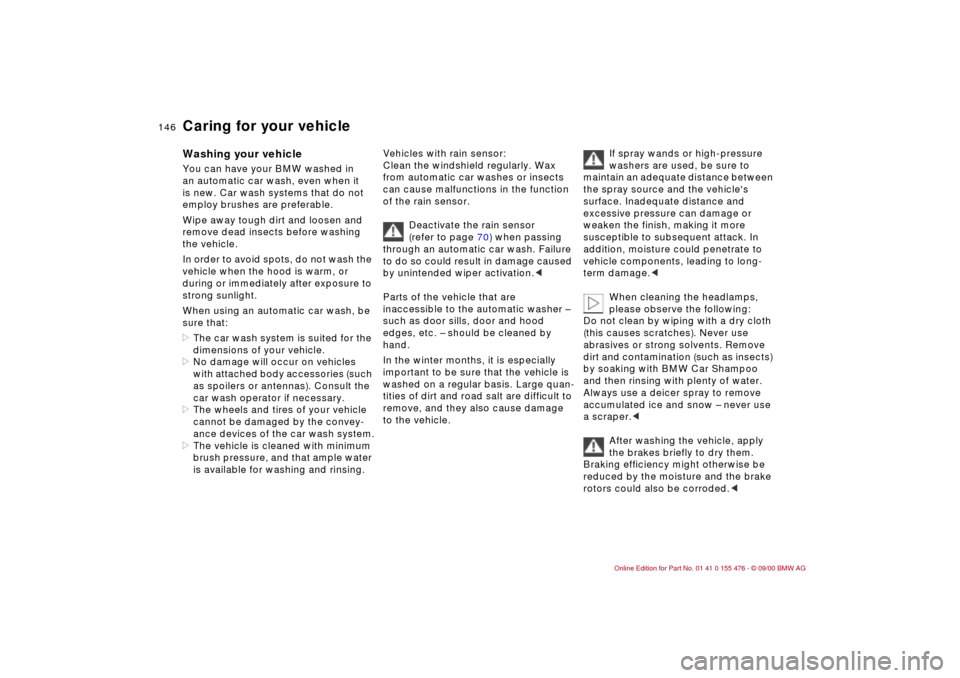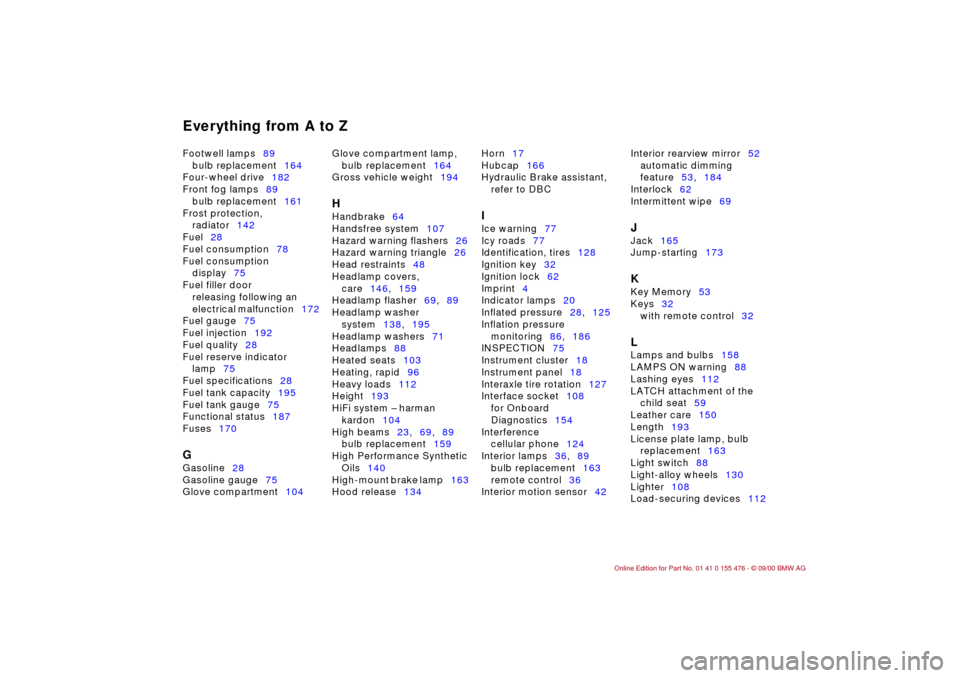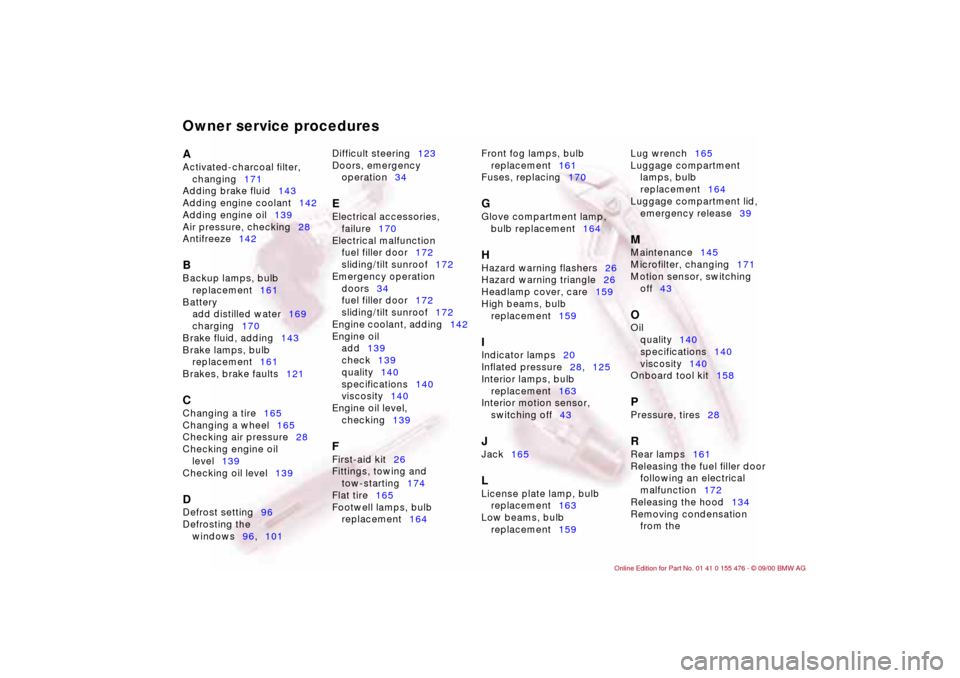2001 BMW 325i SEDAN brake sensor
[x] Cancel search: brake sensorPage 117 of 211

117n
IndexDataTechnologyRepairsCar careControlsOverview
Brakes:
Do not drive with your foot resting
on the brake pedal. Even light but
consistent pedal pressure can lead to
high temperatures, brake wear, and
possibly to brake failure.
Aquaplaning:
Reduce your speed when you drive on
wet or slushy roads. If you do not, a
wedge of water can form between the
tires and the road surface. This
phenomenon is referred to as aqua-
planing or hydroplaning. It is character-
ized by a partial or complete loss of
contact between the tires and the road
surface. The ultimate results are loss of
steering and braking control.
Driving through water:
Do not drive through water that is
deeper than 1 foot (30 cm). If you must
drive through water accumulations up
to that depth, drive only at walking
speed. Driving at a faster speed could
cause damage to the engine, the elec-
trical systems and the transmission.
Package tray:
Never use the rear window shelf to
store heavy or bulky objects. If you do
so, such objects could pose the risk of
injury to vehicle occupants during
braking or evasive maneuvers or in a
crash.
Clothes hooks:
When suspending clothing from the
hooks, be sure that they will not
obstruct the driver's vision. Do not hang
heavy objects on the hooks. If you do
so, such objects could pose the risk of
personal injury during braking or
evasive maneuvers.
use with unleaded fuel only.
Even minute quantities of lead would be
enough to permanently damage both
the catalytic converter and the system
oxygen sensor.
To ensure efficient, trouble-free engine
operation and avoid potential damage:
>Be sure to comply with the scheduled
maintenance requirements.
>Fill the fuel tank well before it is
empty.
>Tow-start only when the engine is
cold. If you attempt to tow-start with
a warm engine, unburned residual
fuel in the catalytic converter could
ignite and cause damage. It is better
to jump-start the vehicle with outside
assistance.
>Avoid other situations in which the
fuel is not burned, or burns incom-
pletely, such as engaging the starter
frequently or for extended periods, or
repeated start attempts in which the
engine does not start (stopping and
restarting an engine which is running
properly does not present a problem).
Never allow the engine to run with
any of the spark plug cables discon-
nected.
Driving notes Catalytic converter
Page 146 of 211

146n
Washing your vehicle You can have your BMW washed in
an automatic car wash, even when it
is new. Car wash systems that do not
employ brushes are preferable.
Wipe away tough dirt and loosen and
remove dead insects before washing
the vehicle.
In order to avoid spots, do not wash the
vehicle when the hood is warm, or
during or immediately after exposure to
strong sunlight.
When using an automatic car wash, be
sure that:
>The car wash system is suited for the
dimensions of your vehicle.
>No damage will occur on vehicles
with attached body accessories (such
as spoilers or antennas). Consult the
car wash operator if necessary.
>The wheels and tires of your vehicle
cannot be damaged by the convey-
ance devices of the car wash system.
>The vehicle is cleaned with minimum
brush pressure, and that ample water
is available for washing and rinsing.Vehicles with rain sensor:
Clean the windshield regularly. Wax
from automatic car washes or insects
can cause malfunctions in the function
of the rain sensor.
Deactivate the rain sensor
(refer to page 70) when passing
through an automatic car wash. Failure
to do so could result in damage caused
by unintended wiper activation.<
Parts of the vehicle that are
inaccessible to the automatic washer Ð
such as door sills, door and hood
edges, etc. Ð should be cleaned by
hand.
In the winter months, it is especially
important to be sure that the vehicle is
washed on a regular basis. Large quan-
tities of dirt and road salt are difficult to
remove, and they also cause damage
to the vehicle.
If spray wands or high-pressure
washers are used, be sure to
maintain an adequate distance between
the spray source and the vehicle's
surface. Inadequate distance and
excessive pressure can damage or
weaken the finish, making it more
susceptible to subsequent attack. In
addition, moisture could penetrate to
vehicle components, leading to long-
term damage.<
When cleaning the headlamps,
please observe the following:
Do not clean by wiping with a dry cloth
(this causes scratches). Never use
abrasives or strong solvents. Remove
dirt and contamination (such as insects)
by soaking with BMW Car Shampoo
and then rinsing with plenty of water.
Always use a deicer spray to remove
accumulated ice and snow Ð never use
a scraper.<
After washing the vehicle, apply
the brakes briefly to dry them.
Braking efficiency might otherwise be
reduced by the moisture and the brake
rotors could also be corroded.<
Caring for your vehicle
Page 180 of 211

180n
ASC+T/DSC
*
Highly sensitive sensors monitor the
number of revolutions of the wheels.
When equipped with DSC, they also
monitor steering angle, lateral accelera-
tion, brake pressure and the movement
of the vehicle around its vertical axis.
If differences in the wheel speeds occur,
ASC+T counteracts the danger of
wheelspin by reducing engine torque; if
necessary, ASC will also respond by
applying the brakes to the rear wheels.
In addition, DSC permanently monitors
the vehicle's current operating condition
and compares it with an ideal condition
that is calculated from the sensor's
signals. If deviations from this occur
(understeering or oversteering, for
instance), DSC can stabilize the vehicle
in fractions of a second by reducing
engine output and with the assistance of
braking intervention at individual
wheels. As a result, dangerous skids can
be prevented even as they are just
beginning, but only within the laws of
physics.
You may need some time to become
accustomed to this system's interven-
tion. However, it provides optimum
drive force and driving stability.
The braking intervention may be
accompanied by sounds specific to the
system.
Page 202 of 211

Everything from A to ZFootwell lamps89
bulb replacement164
Four-wheel drive182
Front fog lamps89
bulb replacement161
Frost protection,
radiator142
Fuel28
Fuel consumption78
Fuel consumption
display75
Fuel filler door
releasing following an
electrical malfunction172
Fuel gauge75
Fuel injection192
Fuel quality28
Fuel reserve indicator
lamp75
Fuel specifications28
Fuel tank capacity195
Fuel tank gauge75
Functional status187
Fuses170 G
Gasoline28
Gasoline gauge75
Glove compartment104 Glove compartment lamp,
bulb replacement164
Gross vehicle weight194
H
Handbrake64
Handsfree system107
Hazard warning flashers26
Hazard warning triangle26
Head restraints48
Headlamp covers,
care146,159
Headlamp flasher69,89
Headlamp washer
system138,195
Headlamp washers71
Headlamps88
Heated seats103
Heating, rapid96
Heavy loads112
Height193
HiFi system Ð harman
kardon104
High beams23,69,89
bulb replacement159
High Performance Synthetic
Oils140
High-mount brake lamp163
Hood release134 Horn17
Hubcap166
Hydraulic Brake assistant,
refer to DBC
I
Ice warning77
Icy roads77
Identification, tires128
Ignition key32
Ignition lock62
Imprint4
Indicator lamps20
Inflated pressure28,125
Inflation pressure
monitoring86,186
INSPECTION75
Instrument cluster18
Instrument panel18
Interaxle tire rotation127
Interface socket108
for Onboard
Diagnostics154
Interference
cellular phone124
Interior lamps36,89
bulb replacement163
remote control36
Interior motion sensor42 Interior rearview mirror52
automatic dimming
feature53,184
Interlock62
Intermittent wipe69
J
Jack165
Jump-starting173 K
Key Memory53
Keys32
with remote control32 L
Lamps and bulbs158
LAMPS ON warning88
Lashing eyes112
LATCH attachment of the
child seat59
Leather care150
Length193
License plate lamp, bulb
replacement163
Light switch88
Light-alloy wheels130
Lighter108
Load-securing devices112
Page 203 of 211

Everything from A to Z
203n
IndexDataTechnologyRepairsCar careControlsOverview
Louvers92,98
Low beam headlamps88
Low beams, bulb
replacement159
Lug bolts166
Lug wrench165
Luggage compartment41
capacity194
floor mat41
floor panel41
remote control37
Luggage compartment
lamps, bulb
replacement164
Luggage compartment
lid39
emergency release39
securing separately39
Luggage compartment
lighting39
Luggage rack113
Lumbar support49 M
M+S tires129
Maintenance75,145
Malfunction displays76
Manual transmission65
Manually controlled
recirculated-air101
Memory50 MFL (Multifunction steering
wheel)24
Microfilter95,171
Mirror memory50
Mirrors52
Mobile phone124
Modifications,
technical6,153
Motion sensor, interior42
Multifunction steering wheel
(MFL)24
N
Neckrest48 O
OBD interface socket154
Obstruction protection44
Odometer74
Oil
capacity195
consumption139
dipstick139
quality140
specifications140
viscosity140
Oil additives139
Oil change intervals, see the
Service and Warranty
Information Booklet
Oil filter change195 Oil level
check139
indicator lamp20
Oil pressure, indicator
lamp20
OILSERVICE75
Onboard tool kit158
Opening and closing Ð from
the inside38
Opening and closing Ð from
the outside34
Outside temperature
display77
Owner service
procedures206
P
Paint blemishes147
Paint, care147
Paintwork, minor
repairs148
Paintwork, waxing148
Park Distance Control
(PDC)79
Parking brake64
Parking help79
Parking lamps89
Parking, winter123
PDC (Park Distance
Control)79
Performance192
Phone, mobile124 Pocket flashlight104
Pollen95,102
Power seat49
Power steering123
Power windows44
safety switch45
Pressure monitoring,
tires86,186
Pressure, tires28,125
R
Radiator195
Radio Data System
(RDS)181
Radio reception124,181
Radio, refer to the separate
Owner's Manual
Rain sensor69,185
RDC (Tire Pressure
Control)86,186
RDS (Radio Data
System)181
Reading lamps90
Rear backrest, folding109
Rear lamps161
Rear window
defroster71,94,102
Rearview mirror52
Recirculated air mode94
Reclining seat47
Refueling27
Remote control35
Page 206 of 211

Owner service proceduresA
Activated-charcoal filter,
changing171
Adding brake fluid143
Adding engine coolant142
Adding engine oil139
Air pressure, checking28
Antifreeze142 B
Backup lamps, bulb
replacement161
Battery
add distilled water169
charging170
Brake fluid, adding143
Brake lamps, bulb
replacement161
Brakes, brake faults121 C
Changing a tire165
Changing a wheel165
Checking air pressure28
Checking engine oil
level139
Checking oil level139 D
Defrost setting96
Defrosting the
windows96,101 Difficult steering123
Doors, emergency
operation34
E
Electrical accessories,
failure170
Electrical malfunction
fuel filler door172
sliding/tilt sunroof172
Emergency operation
doors34
fuel filler door172
sliding/tilt sunroof172
Engine coolant, adding142
Engine oil
add139
check139
quality140
specifications140
viscosity140
Engine oil level,
checking139 F
First-aid kit26
Fittings, towing and
tow-starting174
Flat tire165
Footwell lamps, bulb
replacement164 Front fog lamps, bulb
replacement161
Fuses, replacing170
G
Glove compartment lamp,
bulb replacement164 H
Hazard warning flashers26
Hazard warning triangle26
Headlamp cover, care159
High beams, bulb
replacement159 I
Indicator lamps20
Inflated pressure28,125
Interior lamps, bulb
replacement163
Interior motion sensor,
switching off43 J
Jack165 L
License plate lamp, bulb
replacement163
Low beams, bulb
replacement159 Lug wrench165
Luggage compartment
lamps, bulb
replacement164
Luggage compartment lid,
emergency release39
M
Maintenance145
Microfilter, changing171
Motion sensor, switching
off43 O
Oil
quality140
specifications140
viscosity140
Onboard tool kit158 P
Pressure, tires28 R
Rear lamps161
Releasing the fuel filler door
following an electrical
malfunction172
Releasing the hood134
Removing condensation
from the
Owner service procedure